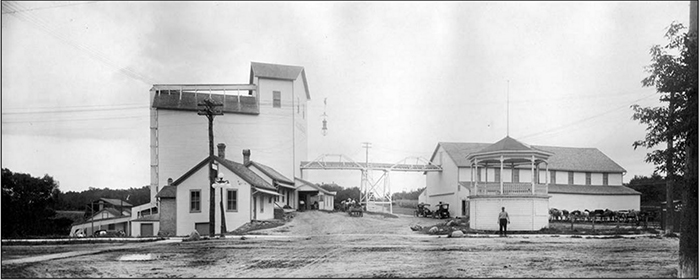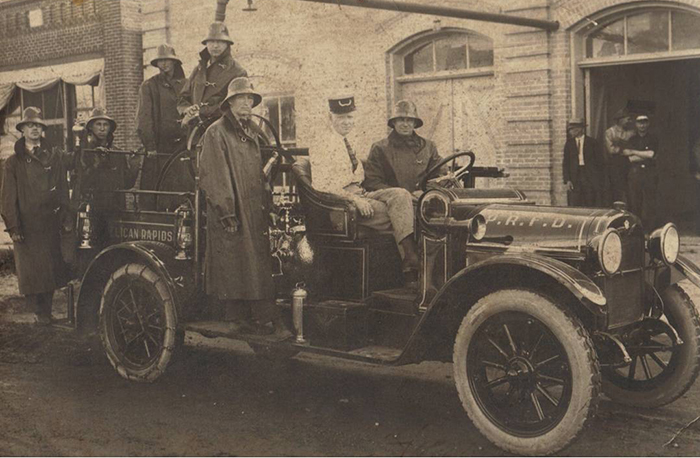Remembering the day the Frazee Mill burned down
News | Published on May 23, 2023 at 5:21pm EDT | Author: frazeevergas
0Pelican Rapids fire changed the area forever

Editor’s Note: The H.E. Frazee Flour Mill in Pelican Rapids was constructed by R.L. Frazee who was one of the patriarchs of the town of Frazee, which also shares his name. This is a look at that fire from May 3, 1923 in Pelican Rapids.

By Paul Gubrud
Special to the Forum
Around mid-morning on Thursday, May 3, 1923, the fire bell atop the village hall began ringing with unusual vigor. The bell was loud and could be heard by everyone in town. It was the call for all firemen to report, and they did so quickly. People left the stores and their houses to see what was going on. They saw a giant, black column of smoke rising above the H.E. Frazee Flour Mill near downtown.
The fire had been discovered at 9:45 by J. F. Logan when he saw plumes of smoke coming out of the roof. He raised the alarm. The Pelican Rapids Fire Department went into action rapidly, but the 64-foot wooden structure was no match for the fire fighting equipment of the day and likely would have been more than a challenge for today’s fire fighting equipment too. The firemen were facing the largest fire any of them had ever seen, and it would be a long day.
The PRFD’s recently purchased 1921 Reo Chemical motorized fire engine was put into action, but the flames were everywhere in the mill and already engulfing the wooden roof. The firemen were unable to pump water high enough to douse the flames. When the powerline poles near the fire began to burn, the electricity in town was shut off. The village water tank behind the village power plant supplying water to the fire engine was quickly drained without electricity to run the pump. Water had to be pumped directly from the river.
Pelican Rapids’ first fire engine, the 1898 hand-pulled Waterous Steam Engine, was pressed unto use again. It was pulled to the wooden bridge behind today’s Ace Hardware and Muddy Moose to pump water. Two hoses were pulled up the hill and down Mill Street to the Reo fire engine at the burning mill. The old steam pumper was kept fired so hot that the engine began to bounce, and soon the entire bridge was shaking in rhythm to the pump. The 1898 Waterous Steam Engine worked hard all day without a complaint, and it was likely the last time it was ever used. The antique Waterous Steam Engine is still in possession of the Pelican Rapids Fire Department and on display at the fire hall. Some former firemen claim it could still work today.
The woman in the bucket brigade
The 1921 Reo Chemical fire engine’s insatiable demand for water was beyond what the old steam fire engine could keep up with, so bucket brigades were formed to carry water from the river.
Decades later, C. A. (Stem) Hanson recalled how the townspeople turned out to fight the mill fire in an interview with Marguerite Andrews.
“They didn’t have much apparatus then before they got this steam engine in 1898. They only had the buckets and the pumping handles of each side of this rig that was towed and pumped by hand. They poured the water into the three hundred-gallon tank, and with a small hose running out, they pumped that. Men from the department and volunteers always came in and helped.
There was a fire in the Frazee Mill Office. The rig was up by the office, and they had the bucket brigade running down to the river on the north side, close to the bridge.
Everybody that wanted to help could. One man’s wife tried to help. Well, I won’t mention any names, but it was in the evening and dark, and this one lady, she jumped in there and wanted to help. She got a bucket, and she was doing pretty good, running up and down. And there were a couple of fellows standing in the river, dipping buckets as they came. And this lady comes back again from her trip up there, and something didn’t suit her just right, and she started telling these fellows how to do it or something. So he made up his mind he was gonna get even with her. He took the pail that he was dipping with right into the bottom and got it half full of sand, and put that in her bucket. She started up the hill, but she could hardly lug it because it was so heavy, half full of sand. She didn’t come back for any more water, either.”
A call for help
When the PRFD realized it would be a bad fire, they would need help. A call was made to Fergus Falls, where they loaded the Fergus fire engine onto a rail car. A locomotive was commandeered for an emergency run to Pelican Rapids, but it took time to get organized. The special train carrying the Fergus Falls fire engine and the volunteers didn’t arrive until about noon. By then, there was no hope of saving the mill. The fire was deemed to be under control, so the Fergus fire engine wasn’t unloaded, and the train was sent back to Fergus Falls.
When the fire department realized there was no hope of saving the mill, attention was paid to preventing the fire from spreading. The intense heat threatened to set fire to other nearby businesses on the south end of downtown. The Frazee gas station, which was the nearest building to the mill, was saved. It was a nearly fireproof building made of tile, and a constant stream of water saved it from destruction. As it was, the window frames were charred, and the windows cracked. The gas station was located on the corner where the Bell Bank is today.
A week later, the Press reported, “The heat was terrific, and in spite of the fact that water was constantly thrown upon the buildings across the street, the glass in the fronts cracked and the paint blistered. It looked for a time that O. J. Lee’s drug store, Carr & Poss’ general store, Logan Bros.’ hardware, and H. T. Hagen’s furniture store were doomed. But the wind, what little there was, was about due north, and this, no doubt, is what saved the buildings referred to above. Had the wind been a little stronger or a little more in the east, the chances are the whole south part of town would have gone up in smoke.”
Other buildings were threatened
There was a light breeze from the north that morning, and residents downwind began to see ash and embers from the mill’s burning cedar shingles raining down on them. Fires were seen in many places in the south part of town, but the owners, with the help of citizens, were on hand to put the fires out. One house, three blocks from the fire, was on fire six times. The embers were dropping out of the sky everywhere in the southern part of town, and charred shingles were found four or five miles to the south, starting some fields on fire.
When the electricity was shut off, the school was without light or power to pump water for their water supply. The school was closed, and many of the teachers and older boys joined in battling the fire. Every able body man and many women in the village also answered the fire call to help. They emptied the mill’s office of the business records and furniture. Attention was then turned to the warehouses containing flour, feed, and coal, most of which were removed and saved before the heat of the fire became too intense. Townspeople also pitched in to help their neighbors extinguish the glowing ember falling out of the sky.
Lynnville Puckett also recalled that day in an interview with Marguerite Andrews.
“On this one particular morning, as Ted Ostrus and I were selling these fish out on the flats by Rothsay, we looked over east here and saw a big flame and puffs of smoke in the sky, and that’s the day that the mill burned down. I don’t remember just the date, but I know it was the first part of May because that’s when the fish always ran the best. About 1923, I would say that the old mill burnt down.
We didn’t know what it was until we came to the railroad tracks on the old Fergus Road about three miles south of town, and here came a train with a fire engine on it. Fergus Falls had shipped their engine up here to help fight this fire. We knew then that there was a big fire in Pelican, but what it was, we didn’t know until we pulled into town. Embers and piles of wheat and grain dust and stuff were still smoldering when we pulled up so we could see the mill.”
The Frazee Mill fire changed Pelican Rapids forever
No single event, before or after, has had such an impact on Pelican Rapids as the Frazee Mill fire. The fire was a wake-up call for the community. The community eventually realized that a municipal water system and better fire protection would be needed if it wanted to grow.
But despite E. L. Peterson’s numerous editorials in the Pelican Press promoting a village water and sewer system, the voters continued to reject the idea, even after the mill fire. It would be over a year before Pelican Rapids began constructing a water and sewer system. The iconic old water tower on top of the hill along North Broadway wasn’t built until the fall of 1924. It served the community for more than 70 years.
Like a Pheonix rising from the ashes, H. E. Frazee began rebuilding the mill before the end of the year, but this time with concrete. The concrete mill would remain in operation for decades to come.
Several notable fires have occurred in Pelican Rapids since then, but none more significant than the Frazee Mill fire in 1923.

